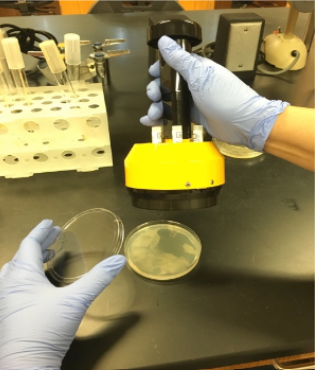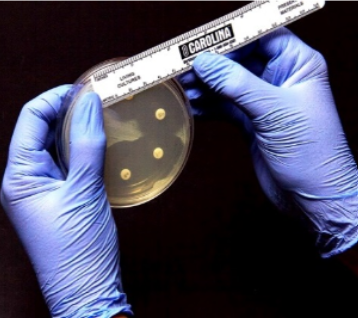15.4: Materials and Procedures
- Page ID
- 40249
The lab exercise on antimicrobial sensitivity is one of my favorites because it highlights antibiotics, one of the most important medical discoveries of the 20 th Century. Few alive today can remember a time before antibiotics existed: when 1 in 7 people died of tuberculosis and 41 years was the average lifespan in the U.S. Now that antibiotic resistant “superbugs” are becoming more prevalent, I feel it is valuable for you to observe first-hand, the proper use and testing protocols for antibiotics.
In this lab, students visualize the effectiveness of 5 different antibiotics against both Gram-positive and Gram-negative bacteria, and draw conclusions about how antibiotics are matched to certain bacterial infections. By replicating a protocol used in clinical labs, I hope you will also gain an appreciation for the strict quality control measures used in the assessment of antibiotics.
~Professor Kelly Cude
Materials
- Per group-
- Staphylococcus saprophyticus
- Staphylococcus epidermidis
- Escherichia coli (all from the Student Stocks)
- 3-Mueller Hinton Agar plates
- 3-TSB tubes
- McFarland Standards and lined cards
- Sterile swabs
- Antibiotic disk dispenser with Chloramphenicol 30μg (C30), Penicillin 10μg (P10), Trimethoprim 5μg (TMP5), Ciprofloxacin 5μg (CIP5), Novobiocin 30μg (NB30)
- Rulers (mm)
Procedures

- Make a suspension of each organism using a sterile swab and compare with the McFarland 0.5 Turbidity standard (use the striped card to help see the turbidity of the standard and the inoculated broth).
- Use another sterile swab for each inoculated TSB to streak a Mueller Hinton plate to create a “confluent lawn” of growth.
- Dispense antibiotic disks on top of the inoculated plates using the disk dispenser. Antibiotics to be tested- Chloramphenicol 30μg (C30), Penicillin 10μg (P10), Trimethoprim 5μg (TMP5), Ciprofloxacin 5μg (CIP5), Novobiocin 30μg (NB30).
- Let disks sit and adsorb onto the agar for a few minutes, then invert and incubate at 35C for 24h-48h (when comparing the Novobiocin results to the unknowns later in the course, make sure that you note the incubation time so that you have an accurate reference point).

- After incubation, measure the zones and compare to the reference chart.
Results
- Enter the size of the zones of inhibition in the chart below:
|
Bacterium/Gram reaction |
C30 (mm) |
P10 (mm) |
TMP5 (mm) |
CIP5 (mm) |
NB30 (mm) |
|---|---|---|---|---|---|
|
Staphylococcus saprophyticus |
|
|
|
|
|
|
Staphylococcus epidermidis |
|
|
|
|
|
|
Escherichia coli |
|
|
|
|
|
- Based on the Zone of Inhibition Chart interpret your results and record below:
|
Bacterium/Gram reaction |
C30 R, I, S |
P10 R, I, S |
TMP5 R, I, S |
CIP5 R, I, S |
NB30 R, I, S |
|---|---|---|---|---|---|
|
Staphylococcus saprophyticus |
|
|
|
|
|
|
Staphylococcus epidermidis |
|
|
|
|
|
|
Escherichia coli |
|
|
|
|
|
Contributors and Attributions
Kelly C. Burke (College of the Canyons)


